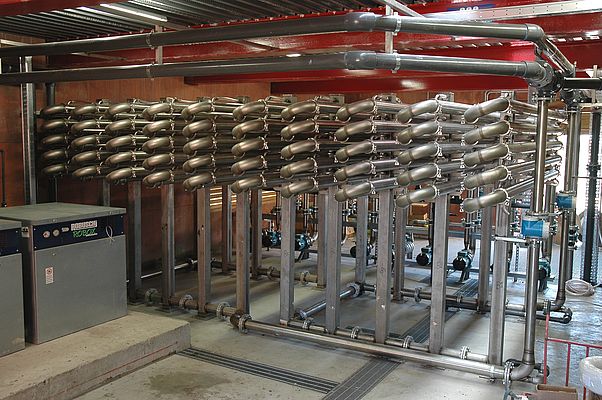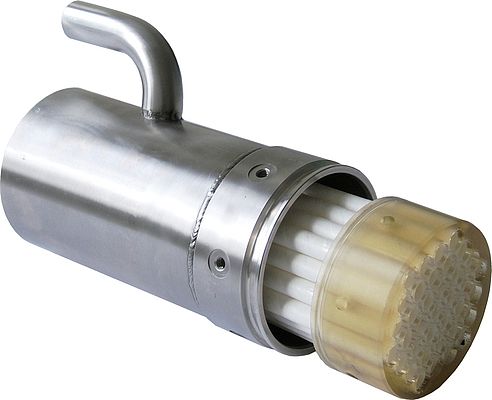High-throughput filtration membranes are at the heart of an extremely compact wastewater treatment plant on Sant'Erasmo island in the Venice lagoon. Engineered by CP Srl, the sidestream bioreactor configuration is one of around 100 in the Venice area alone employing advanced filtering technology.
Venice's wastewater treatment network is highly distributed, with many small processing plants handling groups of houses or buildings, or single large installations such as hotels. The plant on Sant'Erasmo is on an even larger scale. It processes all of the wastewater treatment for the population of the mainly agricultural island as well as wastewater from the densely-populated island of Burano. Isola di Sant'Erasmo is the largest island in the Venetian lagoon, but is sparsely populated. It is an agricultural zone which produces fruit and vegetables for the city and is known as 'The Garden of Venice'.
For this application, which handles up to 1000 cubic metres a day or the equivalent wastewater output of around 4000 people, CP chose to use PCI Membranes' largest stainless steel tubular system, the A37 module. Housing 37 tubular polymeric membranes within a 100mm diameter, 3.66m long stainless steel housing, each A37 module provides a cross-flow filtration surface area of five square metres. As the membranes will operate with a pressure of up to seven bar, multiple modules can be connected in series and driven by pumps to achieve high throughputs.
The system for Sant'Erasmo is a membrane bioreactor - a wastewater treatment system combining biological oxidation with activated sludge and a filtration system. An underground basin handles the sedimentation, de-nitrification and nitrification treatment stages, while the pressurized sidestream filtering system separates the solid and liquid phases. The particular filtration configuration designed for this application is a pumped system with two parallel processing lines constructed using 45 tubular A37 modules each, providing some 450 square metres of filtration area in total. These two processing lines are assembled with U-bend components to form compact processing stacks. The approach allows the complete filtration system to sit on a footprint of less than 5 x 5m, with a height of only 2.8m.
In operation, biomass flows into an activated sludge biological treatment basin or bioreactor for break-down of the organic material. It is cycled through the ultrafiltration plant to remove the sludge and high molecular weight solids. These solids are sent back to the bioreactor until they can no longer be degraded, and are periodically removed for a final de-watering phase and then disposal. Separated particle-free effluent is ozone polished before being re-used for irrigation.
CP has been using PCI Membranes for almost 20 years, and has configured and installed filtration systems for projects ranging from processing landfill leachate to municipal and industrial wastewater treatment. Partly as a result of its extensive work in the Venice region, the company has developed numerous system building techniques and configurations to provide processing plants that are very compact and which can be shaped to fit into available spaces, but which remain maintainable. CP also employs special processing techniques which reduce the energy consumption of sidestream membrane bioreactor configurations by up to 50-60%.
"Sidestream membrane systems are much easier to access and maintain than submersed filtration systems, and are also ideal for sensitive environments such as Venice because there is no need for lifting equipment, which in this case would have increased building height", comments Darren Reed of PCI Membranes. "These attributes, and the system engineering by CP, mean that the Sant'Erasmo installation fits into a single-storey building, allowing the plant to blend unobtrusively into the flat farming landscape."
The CP engineer who worked on the St. Erasmo plant, Silvano Levorin, adds: "Sidestream membrane systems are particularly advantageous for many of the wastewater treatment plant projects we handle, which are in sensitive and conservation areas. We particularly like using PCI Membranes filtration because of the ease with which its tubular-mounted modules can be built into systems and maintained. Almost every system we build is also unique in some way, and PCI Membranes always works with us to provide the components we need for the optimum solution."
Principles of pressure-driven membrane filtration.
In membrane separation processes, a membrane provides an interface between two phases. This interface is a physical barrier that is permeable to some of the species present in one of the streams. In order to carry out the process, a driving force is necessary, in this case pressure. There are in essence four overlapping pressure-driven, cross-flow membrane technologies:
• Reverse Osmosis (RO)
• Nanofiltration (NF)
• Ultrafiltration (UF)
• Microfiltration (MF)
RO uses a tight membrane that retains most dissolved species. The resistance to flow across the membrane is mainly the osmotic pressures of the solution being processed. NF is similar to RO, but allows small inorganic molecules to pass through the membrane. Osmotic pressure is still the major resistance to solvent flow. UF membranes are porous but surface porosity is low at <5% of the surface area. Fractionates dissolved molecules on the basis of size. MF membranes are truly porous with surface porosity >50% in some cases.
Membrane filters power
ultra-compact wastewater plant
- by PCI Membranes Water Process Ltd.
- September 5, 2011
- 257 views


















